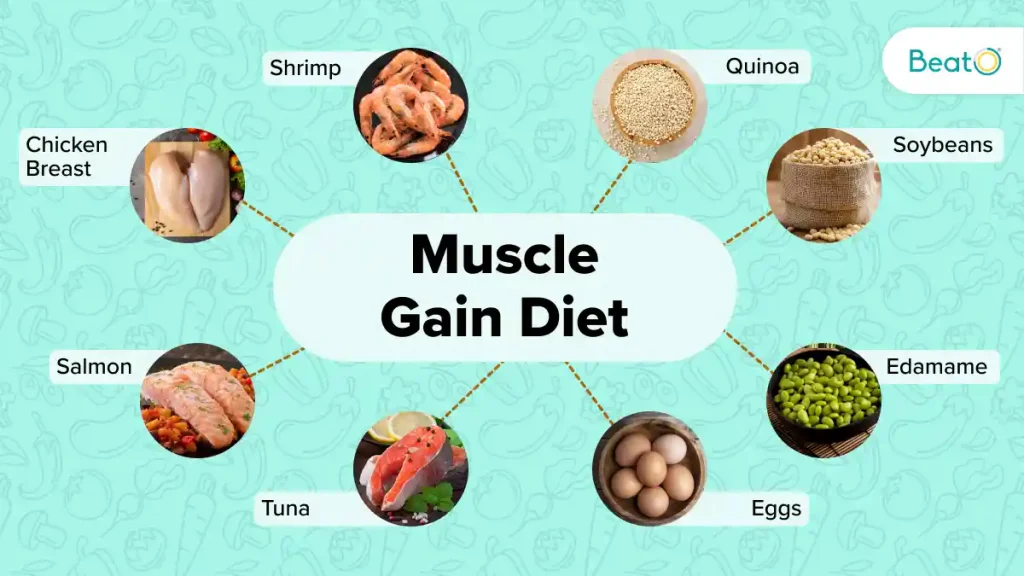Building muscle doesn’t have to burn a hole in your wallet. With the right diet for muscle gain veg and non veg with low budget diet, you can effectively gain lean mass without expensive supplements or premium foods. Whether you prefer a plant-based diet or include animal products, the secret lies in balance, planning, and consistency.
Understanding Muscle Gain on a Budget
Muscle growth happens when your body is in a calorie surplus — consuming more calories than you burn — combined with resistance training. The major nutrients driving muscle gain are protein, carbohydrates, and healthy fats.
Even on a low budget, you can achieve muscle gain if you choose foods that are high in nutrition and affordable. The focus should be on maximizing the protein-to-cost ratio of foods and minimizing wastage through smart planning.
Key Nutrients Needed for Muscle Growth
- Protein: Repairs and builds muscle fibers.
- Carbohydrates: Provide energy for intense workouts.
- Fats: Support hormone balance and recovery.
- Vitamins & Minerals: Boost metabolism and immunity.
Foods like eggs, lentils, milk, and rice are cheap and rich in these nutrients.
Low Budget Veg Diet Plan for Muscle Gain
A vegetarian diet can absolutely help you gain muscle if planned correctly. The trick is to combine plant-based protein sources to ensure you get all essential amino acids.
Budget-Friendly Protein Sources for Vegetarians
- Lentils (Dal): High in protein and fiber.
- Soy Chunks: Great protein source at a very low cost.
- Paneer (Cottage Cheese): Excellent for muscle recovery.
- Tofu: Plant-based and rich in calcium.
- Peanuts & Chickpeas: Affordable and calorie-dense.
Sample 1-Day Veg Muscle Gain Diet Plan
| Meal | Food Items | Protein (Approx.) |
|---|---|---|
| Breakfast | Oats with milk and banana | 15g |
| Mid-Morning | Boiled chickpeas with lemon | 10g |
| Lunch | Brown rice + dal + paneer curry | 25g |
| Snack | Peanut butter sandwich | 12g |
| Dinner | Roti + soy chunk curry + curd | 30g |
Total: ~90g protein
Tips to Maximize Protein Absorption in Veg Diet
- Combine lentils with rice for complete amino acids.
- Add Vitamin C-rich foods (like lemon) to improve iron absorption.
- Use curd or yogurt to improve gut health for better nutrient uptake.
Low Budget Non-Veg Diet Plan for Muscle Gain
Non-vegetarian foods naturally offer complete proteins, making it slightly easier to build muscle on a budget.
High-Protein Yet Affordable Non-Veg Foods
- Eggs: Most cost-effective complete protein source.
- Chicken (especially legs/thighs): High in protein, low in cost.
- Fish (Sardines/Mackerel): Rich in protein and omega-3 fats.
- Milk and Yogurt: Great for post-workout recovery.
Sample 1-Day Non-Veg Muscle Gain Diet Plan
| Meal | Food Items | Protein (Approx.) |
|---|---|---|
| Breakfast | 4 boiled eggs + brown bread | 25g |
| Mid-Morning | Greek yogurt + apple | 10g |
| Lunch | Rice + chicken curry + salad | 35g |
| Snack | Boiled eggs or milkshake | 15g |
| Dinner | Roti + fish curry + vegetables | 30g |
Total: ~115g protein
Balancing Veg & Non-Veg for Best Results
If you mix both diets, you’ll get variety, complete amino acids, and cost savings. For instance, you can have egg breakfast, vegetarian lunch, and chicken dinner to maintain balance and reduce costs.
Smart Shopping Tips for a Low Budget Diet
- Buy staples like rice, lentils, and eggs in bulk.
- Visit local markets for fresh and cheaper produce.
- Prep meals in advance to avoid eating out.
- Use seasonal vegetables — they’re cheaper and more nutritious.
Importance of Hydration and Sleep
Your diet alone isn’t enough. Water helps transport nutrients to muscles, and sleep is when muscle repair actually happens. Aim for 8 hours of sleep and 3-4 liters of water daily.
Supplements: Are They Necessary on a Budget?
Supplements are optional. A well-balanced diet can fulfill your needs, but whey protein can help if you struggle to hit your daily protein goals. Consider budget brands or buying in bulk online.
Common Mistakes to Avoid in Muscle Gain Diet
- Skipping meals or undereating.
- Ignoring recovery and sleep.
- Relying only on protein powders.
- Neglecting hydration and micronutrients.
FAQs about Diet for Muscle Gain Veg and Non Veg with Low Budget Diet
1. Can I build muscle without supplements?
Yes, a well-planned diet with natural protein sources is enough.
2. Is a vegetarian diet enough for muscle gain?
Absolutely! Combine various plant proteins for complete amino acids.
3. What’s the cheapest protein source?
Eggs, lentils, and soy chunks offer the best protein per rupee.
4. How many calories should I eat for muscle gain?
Aim for 300–500 calories above your maintenance level.
5. Should I eat before or after a workout?
Both! Pre-workout carbs and post-workout protein aid recovery.
6. How long does it take to see results?
With consistency, visible results appear in 8–12 weeks.
Conclusion
Building muscle doesn’t demand an expensive diet—it requires smart eating, discipline, and consistency. By following this diet for muscle gain veg and non veg with low budget diet, you can achieve your fitness goals while keeping your wallet happy. Focus on natural foods, hydration, and recovery, and you’ll see strong, sustainable results.
For more guidance on affordable nutrition, visit Healthline’s Budget Muscle Gain Guide.

